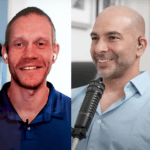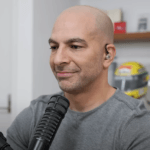It’s the moment right before you need to leave the house, and all of a sudden, panic hits when you can’t remember where you just set down your keys. This occasional inconvenience is likely more a matter of inattentiveness than memory loss and is often resolved by retracing your steps, but with advancing age, many start to notice that similar situations and other memory lapses occur with increasing – and perhaps alarming – frequency. In contrast to the infrequent frustration of searching for misplaced keys, age-related decline in memory function can severely hinder the ability to maintain the activities of daily living.
The varied tasks of daily life rely on both short-term, also called working memory, and long-term memory storage. While I’ve commented in the past on some effective at-home strategies for slowing cognitive decline – including exercise and practicing sensory heightening (we dive into these topics further in the brain health “Ask Me Anything” episode #46) – research exploring the use of electrical brain stimulation in memory-related areas of the brain has shown some promise for lasting improvements. Might this be an up-and-coming therapeutic avenue, or is it only a tool for research?
Transcranial Modulation of Brain Oscillations
The brain naturally produces oscillations through the synchronized electrical activity of millions of neurons (recall my conversations with Dr. Matthew Walker). The synchronized activity of neurons is important for a variety of cognitive processes, including memory. Cognitive decline, and in particular working memory deficits, is related to the decoupling of neural circuits, which appears as a change in the pattern of these oscillations. Previous research has shown that non-invasive electrical brain stimulation can aid in synchronizing and boosting the brain’s own oscillations in older adults, at least temporarily restoring the brain oscillations seen in younger adults during a working memory task. This therapy, known as transcranial alternating current stimulation (tACS), uses electrodes on the scalp to apply a low-intensity sinusoidal electrical current to a particular region of the brain.
In a recent study, Grover and colleagues tested how tACS sessions over several consecutive days can have long-term memory-boosting effects, and that the improvement in the type of memory storage is related to stimulation of different areas of the brain. In a series of experiments, the researchers tested tACS focused in the dorsolateral prefrontal cortex (DLPFC) and the inferior parietal lobe (IPL), two areas of the brain that are known to be involved in memory processes, such as recognition memory, recall of verbal information, and the promotion of long-term memory formation through the organization of working memory. Although many other areas of the brain, such as the hippocampus, also contribute to memory function, the DLPFC and IPL are located in more superficial areas, making these regions ideal targets for transcranial therapy.
Study Design
The subjects, ages 65 to 88 years old, were randomized to receive tACS in the DLPFC, tACS in the IPL, or sham stimulation (control). Subjects with neurological disorders were excluded from the study, but mild cognitive impairment was not an exclusionary criterion. Treatments were given in a double-blind fashion (meaning neither the subjects nor investigators knew who was being stimulated or where they were being stimulated), and participants performed a free recall task while experiencing their assigned stimulation on four consecutive days. In each of the five daily trials, experimenters read a different list of 20 words, and immediately after the list was concluded, the subject was asked to recall as many words as possible. Stimulation was applied during both memory encoding (as the word list was read to participants) and recall (as participants recited the words back). Baseline assessments of recall, mental well-being, and cognitive integrity were evaluated to minimize the contribution of confounding factors.
The serial position of each recalled word tests both working and long-term memory storage. Primacy, recall of the first four positions, assesses long-term memory storage, and recency, recall of the last four positions, assesses working memory storage. Both primacy and recency recall are generally higher than recall of words in the middle of the list.
Recall Task Improvements
Over the first three days, the study found that tACS of the DLPFC resulted in progressive improvement in the probability of primacy recall to 60% compared to a baseline probability of recall of 37%. The improvements were maintained on Day 4. Additionally, tACS of the IPL progressively improved the probability of recency recall throughout the four-day experiment to a maximum of 80% compared to the baseline probability of recall of 57%. The sham group showed no improvements over baseline throughout the four-day experiments in either primacy or recency recall. Although the initial sample size was small (n=20 in each group), the authors were able to repeat these findings in an independent sample of another thirty subjects.
Long-term Improvements
What is perhaps most interesting is that the treatment durations were relatively short, with each of the five runs of neuromodulation taking about 20 minutes, but the effects measured on Day 4 were sustained when the subjects were retested a month later (with no additional stimulation). The probability of primacy recall declined to 54% from an initial maximum of 60% but remained significantly higher than the baseline probability of primacy recall of 37%. Likewise, the probability of recency recall declined to 64% from an initial maximum of 80% but was significantly higher than the probability of recency recall baseline of 57%. While the long-term effects of tACS are not fully understood, one hypothesis is that tACS induces neuroplastic changes by causing synchronization or “phase locking” of the intrinsic rhythms of the brain. Interestingly, the subjects with lower baseline cognitive performance showed higher rates of improvement and more enduring memory improvement. Although it’s impossible to say when the effects might recede, there is a possibility that tACS might be a way to boost memory with intermittent treatments, which would help many older adults maintain their independence later in life.
Direct or indirect effects?
Although memory function through recall was the measurable outcome, it’s unlikely that neuromodulation had direct effects on either form of memory storage. Based on the pattern of results, the authors speculate that neuromodulation of the IPL might instead facilitate temporal context-mediated recall. Temporal context is the feature of “when” something occurred and can cue retrieval of a past event. In the case of word recall, improvements in temporal context might facilitate the separation between successive tasks and minimize interference, leading to an improvement in recency recall. Likewise, the neuromodulation applied in the DLPFC is associated with attentional processes. An increase in attention may be the reason for enhanced encoding in the primary events of the tested series.
The Bottom Line
Whether tACS is acting directly on brain oscillations involved in memory storage or on other cognitive processes related to memory (e.g., attention), the important tangible outcome is whether or not a person experiences an improvement in memory function. Still, gaining a further understanding of how these therapies impact the brain is necessary for ruling out dangerous effects through off-target stimulation. Although this particular study didn’t report any adverse effects, the side effects of tACS tend to be relatively mild and short-lived, such as itching or tingling under the electrodes, and usually resolve upon the termination of the therapy.
But whether this technique will be clinically relevant in the foreseeable future is still questionable. Previous studies have shown that other forms of transcranial neuromodulation, such as tDCS (transcranial direct current stimulation), are effective in other contexts, such as treating disorders related to neuromuscular control. For example, long-term improvements in gait were shown using tDCS of the cerebellum as a treatment for ataxia, with sustained improvements lasting at least three months.
However, while ataxias are typically rare and often debilitating disorders caused by genetics or acute injury, the more complex process of age-related memory loss takes place slowly over time and may be delayed by lifestyle factors such as exercise, raising a question about whether a poorly understood (and possibly costly) neuromodulatory intervention would really be a worthwhile alternative. Improvements in cognition from tACS may thus be more clinically relevant if shown in the case of irreversible neurodegenerative disease, while other, less-expensive, at-home strategies for slowing cognitive decline are probably the best bet for otherwise healthy adults.
Still, with minimal documented risks, tACS is a useful tool for studying the process of memory, an area of research where animal models are notoriously poor substitutes for human biology. Although far from a viable therapeutic option right now, tACS experiments may prove to be invaluable for investigating how the aging process weakens these neural memory circuits, potentially revealing enough that in the future, we might employ more sophisticated techniques in neuromodulation or other areas to exploit the plasticity of the brain and slow memory decline.
For a list of all previous weekly emails, click here.




